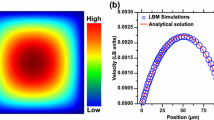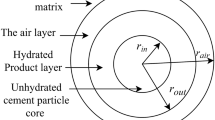Abstract
This paper presents a network model to predict the permeability of cement paste from a numerical simulation of its microstructure. Based on a linked list pore network structure, the effective hydraulic conductivity is estimated and the fluid flow is calculated according to the Hagen–Poiseuille law. The pressure gradient at all nodes is calculated with the Gauss elimination method and the absolute permeability of the pore network is calculated directly from Darcy’s law. Finally, the permeability model is validated by comparison with direct water permeability measurements. According to this model, the predicted permeability of hydrating cement pastes is extremely sensitive to the particle size distribution of the cement and especially to the minimum size of the cement particles. Both in simulations and experiments, the permeability of cement pastes is mainly determined by the critical diameter and by the connectivity of the pore structure, regardless of w/c ratio and curing age. The permeability of cement pastes could be predicted reasonably well when a minimum particle size 1 μm was chosen for the cement.
Résumé
Cet article présente un modèle de réseau visant à prédire la perméabilité de la pâte de ciment à l’aide d’une simulation numérique de sa microstructure. Sur la base d’une liste liée de la structure du réseau de pores, la conductivité hydraulique efficace est estimée et le flux de fluide est calculé selon la loi de Hagen–Poiseuille. Le gradient de pression est calculé à tous les nœuds par la méthode d’élimination de Gauss et la perméabilité absolue du réseau de pores est directement calculée à partir de la loi de Darcy. En conclusion, le modèle de perméabilité est validé par comparaison avec des mesures de perméabilité à l’eau. Selon ce modèle, la perméabilité prévue des pâtes d’hydratation de ciment est extrêmement sensible à la distribution des dimensions des particules du ciment et particulièrement à la taille minimale. Dans les simulations ainsi que dans les expériences, la perméabilité des pâtes de ciment est principalement déterminée par le diamètre critique et par la connectivité de la structure de pore, indépendante du rapport de l’eau au ciment et de la période de traitement. La perméabilité des pâtes de ciment pourrait être raisonnablement bien prédite lorsque l’on choisit 1 μm comme dimension de grain minimale du ciment.
Similar content being viewed by others
References
Garboczi EJ (1990) Permeability, diffusivity, and microstructural parameters: a critical review. Cement Concrete Res 20:591–601
Marchand J, Gerard B (1997) Microstructure-based models for predicting transport, Penetration and permeability of concrete. In: Reinhardt HW (ed) RILEM report 16, London SEI 8HN UK E & FN Spon, pp 41–81
Garboczi EG, Bentz DP, Frohnsdorff GJ (2000) The past, present, and future of the computational materials science of concrete, Proceedings of the J. Francis Young Symposium Materials Science of Concrete Workshop, Lake Shelbyville, IL, April 27–29, pp 1–10
Ye G, van Breugel K, Fraaij ALA (2003) Three-dimensional microstructure analysis of numerically simulated cementitious materials. Cement Concrete Res 33(2):215–222
Ye G, Hu J, van Breugel K, Stroeven P (2002) Characterization of the development of microstructure and porosity of cement-based materials by numerical simulation and ESEM image analysis. Mater Struct 35:603–613
van Breugel K (1991) Simulation of hydration and formation of structure in hardening cement-based materials. Ph.D. Thesis Delft University of Technology, The Netherlands
Ye G (2003) Experimental study and numerical simulation of the development of the microstructure and permeability of cementitious materials. Ph.D. Thesis, Delft University of Technology, Delft
Ye G, van Breugel K, Fraaij ALA (2003) Numerical and experimental studies of percolation phenomena of hardening cement paste”, Proc. Celebrating concrete: people and practice. Dundee, Scotland, September, pp 103–112
Ye G, van Breugel K (2003) Pore structure of cement paste from nano-scale to micro-scale. Accepted for publication in 1st international symposium on Nanotechnology in Construction, Paisley, Scotland, June, pp 175–183
Dullien FAL (1992) Porous media: fluid transport and pore structure, 2nd edn. Academic Press, Inc
Garboczi EJ, Bentz DP (1992) Computer-based models of the microstructure and properties of cement-based materials, Vol 5. 9th International Congress on the Chemistry of Cement, New Delhi India, pp 3–15
Pignat C, Navi P, Scrivener K (2003) Simulation of cement paste microstructure during hydration, characterization of the pore space and permeability determination, Vol 1. 11th International Congress on the Chemistry of Cement, Durban South Africa, pp 197–205
Acknowledgements
This research was financially supported by the Dutch Technology Foundation (STW), which is gratefully acknowledged.
Author information
Authors and Affiliations
Corresponding author
Rights and permissions
About this article
Cite this article
Ye, G., Lura, P. & van Breugel, K. Modelling of water permeability in cementitious materials. Mater Struct 39, 877–885 (2006). https://doi.org/10.1617/s11527-006-9138-4
Received:
Accepted:
Published:
Issue Date:
DOI: https://doi.org/10.1617/s11527-006-9138-4




